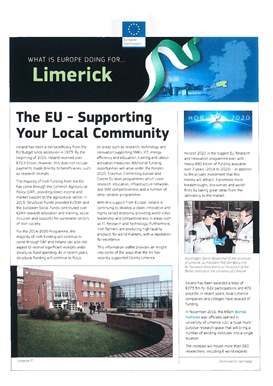Ireland's county by county approach: how much EU money for Donegal?

date: 01/06/2017
Programme by programme, Ireland has received most of its subsidies through the Common Agricultural Policy. Ireland has been a net beneficiary from the EU budget since its accession in 1973, receiving over €72.5 billion by the beginning of 2015. This does not include payments made directly to beneficiaries, such as research receipts. Structural funds provided €150 million, and the European Social Funds over €24 million.
For instance, in Limerick this means sizeable amounts of funding for research institutes and companies in the framework of the Horizon 2020 programme. Limerick's city centre received over €50 million for urban development projects. Further subsidies went to young entrepreneurs, rural development, youth projects, creative projects, and to coastal regions. Every citizen in the county can see how taxpayers' money affects their neighbourhoods.
'This series of publications was born out of the need to persuade the Irish people to vote "Yes" in the second referendum on the Lisbon Treaty in 2009. At the time, we were reflecting on what we could do to make the EU appear more relevant to people which is why we concentrated on the "county" level', explains Timothy Hayes, Head of the Information/Communication Sector of the Commission Representation in Dublin.
'When first produced in 2009, we printed many thousands of copies which we sent to public representatives, local groups etc. as well as having them at all the local events that we organised for the public around the country. However, as time went on and in particular as we were updating the information sheets annually, we stopped ordering print-runs of copies and instead made the publication electronic, but print-friendly', says Timothy Hayes.
The leaflets are normally updated towards the end of each year with the new version being made available in February.
Timothy Hayes is, however, uncertain about the future of this series: 'To a certain extent, the need for this sort of publication has been overtaken by the obligations on Member States to publicise the funding that has been granted under the Regional funds during the current MFF. But in the case of Ireland, for example, it was only last month that they got the website up and running: http://eufunds.gov.ie/'. If a Representation is reflecting on the possibility of producing a similar series, they should check first whether their Member State's government is already doing something similar.
Website: http://ec.europa.eu/ireland/services/publications_en_en
Contact: Timothy Hayes, e-mail: timothy.hayes@ec.europa.eu
